Inside the Playbook: Penn State, Wisconsin, and Michigan and the Use of False Blocks
As a defender, you are tasked with reading your keys in order to properly diagnose the play and fulfill your assignment. Gap responsibility and run fits and execution all start with properly seeing what is happening in front of you, and based on what the offensive line does, will change your path to success. But offenses know this. To a degree, and offense does what it does because that's the easiest and most efficient way of finding success. Other times, they find success with mind games, by showing something and doing another. This post is going to look at "False Blocks", the art of pass setting on runs and false pulls.
Draw Play
The most obvious example of this is the basic draw play. There are dozens of ways to execute a draw play, and I detailed some of the techniques here. The idea is that you are selling pass with high hats and short sets and then working to the second level.
Screen pass
Your traditional screen is similarly going to invite the pass rush before releasing to the second level. Here, however, you want to invite them further upfield because you can throw over top of them (and you don't need to transition a pass drop into forward momentum). Typically something like a two count will be used in pass drop for releasing OL, the remaining OL, will engage and carry the defenders to depth.
Pullers on Play Action
"A very wise coach once told me, 'If you really want play-action, you better pull a guard." That quote I got from Smart Football has always stuck with me. Here, you are pulling a guard on play action, and once he pulls to his spot, he is replacing an OL at the drop depth rather than continuing to work to the second level. The "false pull" is another signal to second and third level players that it is a run, when in fact it's a pass.
Wisconsin End Around
Those were the conventional examples that almost everyone is aware of. But we also see more "false blocks" in other more creative plays, and that's what I want to present now.
Here's an example that Wisconsin showed last year on their end around that utilizes "false pulls" or "influence blocks". Wisconsin utilized a lot of Power and counter with a backside OG (BSG) pull and a backside H leading. But here, the Center and what is traditionally the playside guard (PSG), rather than stay square on their traditional downblocks, are going to turn just a little bit more to allow them to cutoff the defender from gaining initial penetration, and by staying on the outside shoulder, they can then bounce out on pull. There initial cutoff pushes their defender directly into a backside downblock so that they can release upfield and find work.
But the false pulls from the traditional BSG and backside H take the second level mostly out of the play. They read power and go to attack it down field, only to be taking themselves out of the play entirely. By the time the end around occurs, it's a DB vs a OL to set the edge, which is a good matchup for the offense.
Lead Power O From Dos:
Influence Trap/Wham
I've covered Wham and influence wham previously, so will just link to that article. But the basic idea is that a front side OL is going to act as if he's pulling outside, as he traditionally does for Down G or pin and pull. Interior OL, accustomed to "block down, step down" are often going to trying to grab onto the pullers butt and follow him down the line. Similarly, LBs and other second and third level defenders are going to sprint to the edge to avoid getting leverage and attempt to squeeze the play back inside. However, this front side pull is a clever ruse. An additional trapper or wham block is coming from the backside, and the play is designed to go inside, where there is now an alley between the backside (which has been cut off) and the front side, which has tried to set the edge.
James Light has provided some great detail in the past:
Backside Sweep Influence Pull
The sweep is a fast hitting play. In fact, many on the sweep play won't even block front side 3-tech. So backside blocks are really there to serve as more of a cutoff. But if you already aren't blocking the front side 3-tech because he can't make a play on the ball, then those OL are releasing to the second level to cut off those players anyway. Why not utilize a backside blocker to further influence the second and third level? That what some teams do.
This is a bit of a different play, where this is actually a read, but shows the G-Lead to both sides, one with a sweep, one with the QB. Backside can't catch up to the frontside sweep, so the backside pull in safe.
Here's a play that looks like, power, is power, everywhere except with the Center. The center, which typically will down block the backside of the play to prevent a defender from following the puller, here logs that player instead. If the backside LB is quick-flowing to the power side of the ball, the "scissors" call can influence them away from the football and allow for a nice run alley.
OG Split Zone
One more false pull, this time with a pull on what is actually split zone. Here, however, rather than a FB or TE running a split zone, an uncovered frontside OL is going to pull to the backside of the play and trap the backside DE. As an uncovered OL, typically he would combo to the second level, but here, the FB or TE will insert himself into the run and make that second level block. The influence of the pull will generally make it look like Power and get the defense to flow, but the rest of the unit is merely running inside zone (RB has to remember that this also forms a strong inside zone cutback opportunity that basically acts like a long trap).
I've only seen this run once at the college level. It resulted in a 3 yard loss. It was a poor example of how to run it, so I won't link it.
Penn State Pass Set (Power, Counter)
Now let's touch on something a little different. Instead of false pulls, we are going to look at "false pass sets". This is typically done to the playside of certain plays to invite the defensive line up field, and therefore widen the hole that is being attacked. In many ways, inviting them upfield and utilizing the momentum against them is easier than kicking them out. Get a bull of a DE that loves to get into the pass rush, and they can widen the hole themselves by being aggressive.
Here's an example with Dart, and look just how wide the whole gets as the DE is "kicked" by working upfield in his pass rush.
Here' a counter OH example. Instead of the O kicking, he will be replaced by the pass set to the playside, and now he will insert himself to take over what is typically the PST's block.
Half Line RPO
Here's what I previously said about this
QB Screen
A draw play, but with screen blocking. What are we living in, some kind of crazy land?
The QB Screen
Draw Play
The most obvious example of this is the basic draw play. There are dozens of ways to execute a draw play, and I detailed some of the techniques here. The idea is that you are selling pass with high hats and short sets and then working to the second level.
Screen pass
Your traditional screen is similarly going to invite the pass rush before releasing to the second level. Here, however, you want to invite them further upfield because you can throw over top of them (and you don't need to transition a pass drop into forward momentum). Typically something like a two count will be used in pass drop for releasing OL, the remaining OL, will engage and carry the defenders to depth.
Pullers on Play Action
"A very wise coach once told me, 'If you really want play-action, you better pull a guard." That quote I got from Smart Football has always stuck with me. Here, you are pulling a guard on play action, and once he pulls to his spot, he is replacing an OL at the drop depth rather than continuing to work to the second level. The "false pull" is another signal to second and third level players that it is a run, when in fact it's a pass.
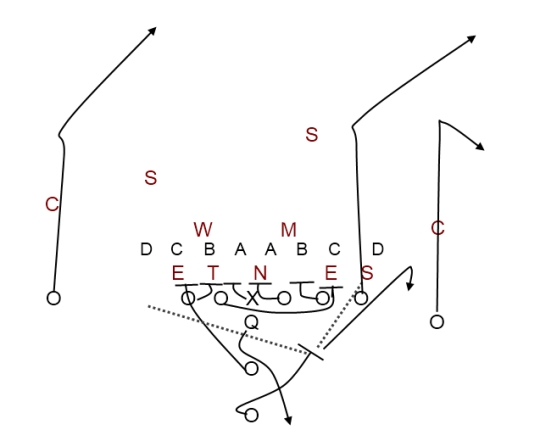 |
| Smart Football |
Wisconsin End Around
Those were the conventional examples that almost everyone is aware of. But we also see more "false blocks" in other more creative plays, and that's what I want to present now.
Here's an example that Wisconsin showed last year on their end around that utilizes "false pulls" or "influence blocks". Wisconsin utilized a lot of Power and counter with a backside OG (BSG) pull and a backside H leading. But here, the Center and what is traditionally the playside guard (PSG), rather than stay square on their traditional downblocks, are going to turn just a little bit more to allow them to cutoff the defender from gaining initial penetration, and by staying on the outside shoulder, they can then bounce out on pull. There initial cutoff pushes their defender directly into a backside downblock so that they can release upfield and find work.
But the false pulls from the traditional BSG and backside H take the second level mostly out of the play. They read power and go to attack it down field, only to be taking themselves out of the play entirely. By the time the end around occurs, it's a DB vs a OL to set the edge, which is a good matchup for the offense.
Lead Power O From Dos:
Counter H from a tight bunch:
Influence Trap/Wham
I've covered Wham and influence wham previously, so will just link to that article. But the basic idea is that a front side OL is going to act as if he's pulling outside, as he traditionally does for Down G or pin and pull. Interior OL, accustomed to "block down, step down" are often going to trying to grab onto the pullers butt and follow him down the line. Similarly, LBs and other second and third level defenders are going to sprint to the edge to avoid getting leverage and attempt to squeeze the play back inside. However, this front side pull is a clever ruse. An additional trapper or wham block is coming from the backside, and the play is designed to go inside, where there is now an alley between the backside (which has been cut off) and the front side, which has tried to set the edge.
James Light has provided some great detail in the past:
. @All22ChalkTalk Here is Michigan/Harbaugh running the Influence Wham vs the 3 Deep/2 Under A Gap Cross Dog https://t.co/4KGadhTu2H pic.twitter.com/vptJl19Yj4— James Light (@JamesALight) December 20, 2016
I've talked about this play a lot on here w/ Harbaugh's OFF. Influence Wham where you can get 3 traps in one play. UM terminology = Crunch pic.twitter.com/6HKju5jYBD— James Light (@JamesALight) June 2, 2017
Backside Sweep Influence Pull
The sweep is a fast hitting play. In fact, many on the sweep play won't even block front side 3-tech. So backside blocks are really there to serve as more of a cutoff. But if you already aren't blocking the front side 3-tech because he can't make a play on the ball, then those OL are releasing to the second level to cut off those players anyway. Why not utilize a backside blocker to further influence the second and third level? That what some teams do.
This is a bit of a different play, where this is actually a read, but shows the G-Lead to both sides, one with a sweep, one with the QB. Backside can't catch up to the frontside sweep, so the backside pull in safe.
Power ScissorsHere’s the clip of UCF running Double G-Lead Read. pic.twitter.com/l3F3yvyDaX— Zach Dunn (@ZachSDunn) June 17, 2018
Here's a play that looks like, power, is power, everywhere except with the Center. The center, which typically will down block the backside of the play to prevent a defender from following the puller, here logs that player instead. If the backside LB is quick-flowing to the power side of the ball, the "scissors" call can influence them away from the football and allow for a nice run alley.
— Ben Fennell (@BenFennell_NFL) November 1, 2017
OG Split Zone
One more false pull, this time with a pull on what is actually split zone. Here, however, rather than a FB or TE running a split zone, an uncovered frontside OL is going to pull to the backside of the play and trap the backside DE. As an uncovered OL, typically he would combo to the second level, but here, the FB or TE will insert himself into the run and make that second level block. The influence of the pull will generally make it look like Power and get the defense to flow, but the rest of the unit is merely running inside zone (RB has to remember that this also forms a strong inside zone cutback opportunity that basically acts like a long trap).
I've only seen this run once at the college level. It resulted in a 3 yard loss. It was a poor example of how to run it, so I won't link it.
Penn State Pass Set (Power, Counter)
Now let's touch on something a little different. Instead of false pulls, we are going to look at "false pass sets". This is typically done to the playside of certain plays to invite the defensive line up field, and therefore widen the hole that is being attacked. In many ways, inviting them upfield and utilizing the momentum against them is easier than kicking them out. Get a bull of a DE that loves to get into the pass rush, and they can widen the hole themselves by being aggressive.
Here's an example with Dart, and look just how wide the whole gets as the DE is "kicked" by working upfield in his pass rush.
RT'd something a few weeks ago about pass setting on the front side of Power/Counter. Here's an example of PSU doing it in the Rose bowl. Look how it opens up the wrap hole for Dart https://t.co/mmo3pkHWVB— Space Coyote (@SpaceCoyoteBDS) August 27, 2018
Here' a counter OH example. Instead of the O kicking, he will be replaced by the pass set to the playside, and now he will insert himself to take over what is typically the PST's block.
Kyle Long with the finish, the pancake, and then the staredown! 😂😂😂 @Ky1eLong— Ben Fennell (@BenFennell_NFL) August 19, 2018
Also, Chicago will be pleasantly surprised by Trey Burton in the run game. pic.twitter.com/CDIWq2b7eC
Half Line RPO
Here's what I previously said about this
Half line blocking allows the front side of the play to block the run play (typically pin and pull or outside zone) while the backside pass sets. Since the read is the backside of the play, the backside of the OL isn't required to get to the second level because the pass threat is blocking the backside defense. They chase, you throw, they wait, you run. The pass set gives the QB a little extra protection to get the ball out so that you minimize free rushers to the QB and improve backside throwing windows. Similarly, it prevents OL from getting down field too early.So, that.
force the give on rpo's. a perfectly executed run goes for 6 yds— betz (@alltwentytwo) August 16, 2018
if 52 reads run its an easy 10 yd gain
(I think this was a presnap decision but thats not the point) pic.twitter.com/725Cqv68uG
QB Screen
A draw play, but with screen blocking. What are we living in, some kind of crazy land?
The QB Screen




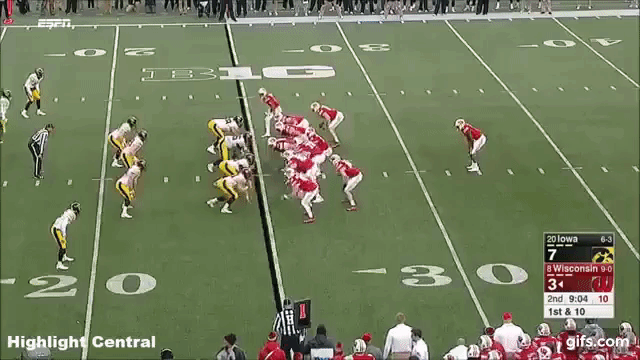
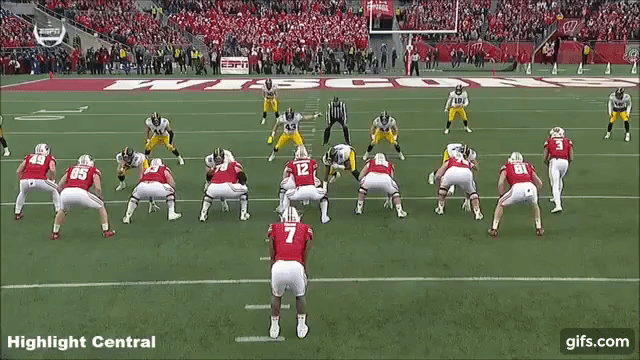
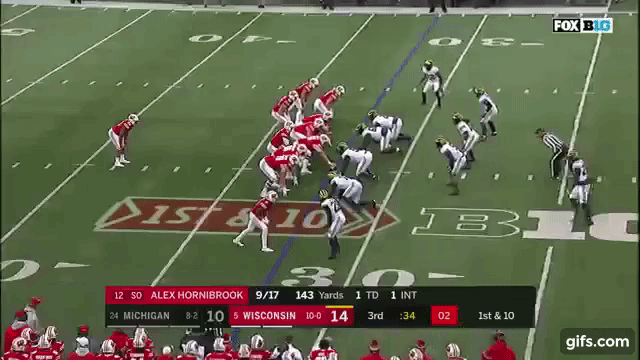
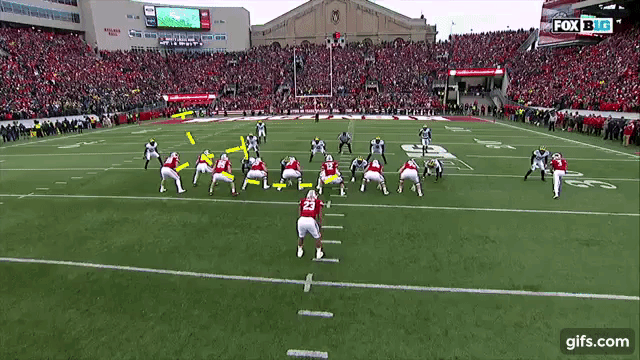








Comments
Post a Comment